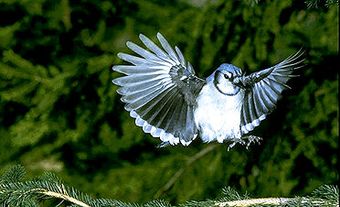Thrushes (Muscicapidae) are a very large family comprising about 450 species of small passerines (perching birds) ranging 11-33 cm in length. Because of its diversity, the family has been divided into subfamilies, one of which, Turdinae (108 species), is devoted to true thrushes alone.
Thrushes have almost worldwide distribution; they can be arboreal or terrestrial. Thirteen species regularly occur in Canada: northern wheatear (Oenanthe oenanthe), eastern, western and mountain bluebirds (Sialia sialis, S. mexicana and S. currucoides, respectively), Townsend's solitaire (Myadestes townsendi), veery (Catharus fuscescens), grey-cheeked, Bicknell's, Swainson's, hermit, wood, and varied thrushes (C. minimus, C. bicknelli, C. ustulata, C. guttata, Hylocichla mustelina, Ixoreus naevius) and American robins(Turdus migratorius).
Thrushes are usually solitary or in pairs, although they flock readily during the nonbreeding season and during migrations. All of the above thrushes are largely migratory.
The plumage of thrushes can be very glossy in some species. Combinations of browns, greys, olives, black, white, chestnut and blue are often blended or contrasted in adults. Males are often more brightly coloured than females. Plumage of immature birds is almost always spotted. The bill varies in length but is usually short, straight and slender; it may curve downward at the tip and have a small notch on the mandible.
The short tail can be square or slightly rounded. Wings are long and pointed, with 10 primary feathers. In most species, the feet are strong and stout and the front of the leg is covered with an undivided sheath.
Thrushes, with their extremely varied voices and highly developed songs, are considered by many to be the best singers among birds. The hermit thrush is judged by some to have the most melodious song of all Canadian birds.
Insects and other small invertebrates are their main food, but small fruits and berries are eaten in season.
For nesting, thrushes construct an open cup, often reinforced with a rim of mud, lined with grass or leaves. It is placed on the ground or in a bush or tree. Thrushes lay 2-6 eggs, which may be white, greenish to bluish white or olive green. Eggs may be speckled. Both parents incubate eggs and take care of young until they leave the nest.

 Share on Facebook
Share on Facebook Share on X
Share on X Share by Email
Share by Email Share on Google Classroom
Share on Google Classroom






